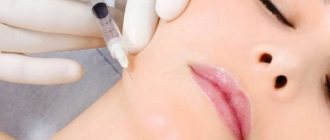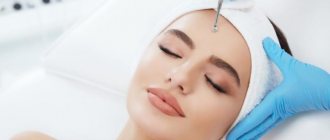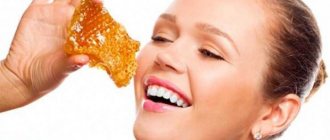My history
“Look, no matter how much you have to walk under a veil all your life,” I received such friendly parting words several years ago, when I decided to try fractional laser rejuvenation.
“Well, stay with your strawberry and cucumber masks,” I joked. I did not believe at all in their miraculous power, capable of smoothing out wrinkles and tightening the face. On the contrary, she believed in high technology. And it was this technique, studied far and wide, that seemed to me the best choice. The procedure was done by the best specialist, in late autumn. The result exceeded all expectations. However, summer came, the sun warmed up, and it was discovered... Even if not a veil, but a wide-brimmed hat and “sun protection” of at least SPF 50 - that’s my lot. But even they are unable to prevent the fact that the previously even and golden tan has now been replaced by light spotting. In some places it is lighter, in others it is darker. And the whole face (toned up and without wrinkles) generally looks motley due to pigmentation disorders. In a word, beauty, and nothing more. After taking a closer look and talking with those around me, I discovered that I was not the only one facing this problem. “The Motley Case” can be safely opened in relation to resurfacing, dermabrasion and chemical peels, which are very popular today. And the latter, by the way, are recommended today as an off-season procedure. “Pigmentation after peeling and other procedures does occur, and quite often,” explains Natalia Polonskaya. – Even if some traumatic procedure was done before summer, the skin still remains activated for a long time - it is characterized by increased activity of melanocytes. These skin cells, which produce the pigment melanin, can react to increasing heat, climate change and other factors. And if the procedure takes place during a period of high solar activity, the risk of pigmentation disorders increases even more. Therefore, with regard to many technologies that injure the skin (electrical, laser and photoepilation, laser resurfacing, photorejuvenation, effects on blood vessels, etc.), an immutable rule applies - their season begins in October and ends in March. As for pigmentation after peeling, you need to clearly understand their classification according to the depth of impact. Peels that damage living epidermal cells in the sunny season can only be done if there are compelling reasons, after weighing the possible risks and benefits. Peels with exfoliation within the stratum corneum of the epidermis can be done without a summer break, but with an interval of at least 7-14 days.
Care after deep peeling
Deep peeling with chemicals is a difficult medical procedure, which is performed exclusively for indications: for large scars and significant scars, to eliminate age-related problems or stretch marks. Care after such a procedure includes the following:
- limit contact with the external environment as much as possible - do not go outside again, do not touch your face with your hands;
- use only soft care products, such as foam;
- Do not use decorative cosmetics until the skin is completely healed.
After such a procedure, the skin’s protective barrier weakens, so the body is easily susceptible to diseases. Deep peeling is contraindicated in the following cases: chronic diseases, the entire period of pregnancy and lactation, diseases of the gastrointestinal tract, endocrine and cardiovascular systems. To reduce the likelihood of skin infection, your doctor may prescribe antibacterial agents and pain relievers.
Sun traps
According to Natalia Polonskaya, it is still wrong to draw direct parallels between anti-aging procedures, the sun and skin pigmentation disorders. There are people who do not give such a reaction, even immediately after peeling when exposed to the sun. For others, the first rays of sunlight are enough for the appearance of freckles and spots. There are several main reasons for the appearance of pigmentation disorders.
General rules of care
Regardless of the type of peeling, after undergoing it, all patients are recommended to do the following:
- For the first 12 hours, it is better not to touch the skin with your hands, not to wash your face or apply any products, and also to avoid exposure to cold wind and direct sunlight.
- For the first 2-3 days after the procedure, it is better to use light, gentle foams and gels for washing. Creams are allowed only on day 3. It is also better to avoid contact with the external environment.
- Two weeks after the procedure, you must strictly follow the cosmetologist’s instructions - take medications, use medicinal care products. It is not recommended to visit baths and saunas or apply decorative cosmetics.
If a crust forms, you should not try to peel it off; it is better to let the skin heal on its own. The most important rule is to avoid infection, so it is recommended to keep the skin clean and not touch it with your hands. When the skin begins to heal, be sure to apply products with a high level of SPF protection before going outside. Not 15, as in standard ones, but 30, or even 50 - GIGI SPF 50 sunscreen would be an excellent option.
— Skin phototype
Whether or not pigmentation appears after peeling or another procedure primarily depends on the skin phototype. With the first phototype (very fair skin, blond or red hair, blue eyes), the risk of pigmentation is close to zero. With the second phototype (fair skin, brown hair, green, gray or blue eyes), it increases. And starting from the third (normal skin, with a natural color, hair - from dark blond to light brown, brown eyes) its probability is quite high. The situation is aggravated if the woman is in a group that constantly uses contraceptives. Their intake, like hormonal disorders, increases the activity of melanocytes. Hereditary predisposition to pigmentation also plays an important role.
— Penetration depth
Uneven tanning or pigmentation disorders may be associated with the depth of the treatment. When peeling, the penetration of the active substance is not the same everywhere: somewhere it penetrates deeply, and somewhere it acts more superficially. In different areas, the skin has different thickness and other characteristics. As a result, in some places it regenerates quickly and completely, while in others, rehabilitation after peeling takes longer.
— Individual skin characteristics
Different people have different areas of skin that are prone to pigmentation differently. For example, chloasma or melasma (a disorder of skin pigmentation resulting from increased production of pigment) appears in different places: for some on the cheekbones, for others on the forehead, etc. Sometimes peelings can trigger the onset of melasma.
— External reasons
The appearance or intensification of hyperpigmentation can also be caused by external reasons. For example, pigmentation disorders often occur around the mouth: this may be due to the use of lipstick or the ingestion of juice droplets and food particles that act as irritants and photosensitizers. Deeper penetration of peeling and the appearance of pigment spots in the eye area can provoke tears, which appear both with various emotions and when the breeze blows.
Precautionary measures
Skin preparation and rehabilitation help to avoid pigmentation after peeling or other procedures. In my case there were none. Moreover, no one offered them to me. And, as it turned out, here again I was not alone. The importance of such precautions is underestimated not only by patients, but also by cosmetologists themselves; many prefer to save on them.
“If the procedure, in particular peeling, damages the skin only within the stratum corneum, preparation and rehabilitation after peeling are not necessary,” explains Natalia Polonskaya. – In this case, competent and balanced home care is important. So that, for example, the patient does not come home after the procedure and rub his skin with sea salt. When peeling with damage to living cells, timely care for restoration and protection significantly reduces the risk of damage from the sun and other factors.
To prepare the skin for chemical peeling in order to prevent pigmentation disorders, drugs that inhibit melanin synthesis can be used in advance, for two to three weeks (such substances include hydroquinone, arbutin, kojic acid, glabridin, etc.) Rehabilitation after peeling, like me I have already said that it consists of measures for emergency restoration and protection of the skin. Our clinic has developed a universal technique that, in various modifications, can be used after any skin damage (burns, frostbite, chapping, laser exposure, herpes, abrasions, etc.) and consists of home care products and, if necessary, professional procedures. The home care includes a cleanser that gently removes flakes without damaging the skin, an alcohol-free soothing lotion, a revitalizing gel and a revitalizing cream with SPF. This is the minimum set that promotes skin regeneration. If the procedure causes significant peeling, in-clinic care may be required. It is necessary to relieve discomfort, gently remove scales, and reduce irritation and redness of the skin. To do this, an enzymatic peeling based on whey is applied to the skin, and then drugs that promote rehabilitation after peeling. In an unusual situation, rehabilitation is adjusted. Sometimes you may need antiseptic drugs or (for a herpetic infection) drying antiherpetic drugs, for a dense crust - drugs that facilitate the separation of the scab, for severe inflammation - anti-inflammatory and decongestant drugs. The number of procedures also depends on the problem: it ranges from one to five.
If you are doing a fairly traumatic procedure, play it safe. No one knows how the skin will react to it. Today the result may be good, but tomorrow it may not be so good. Yes, these are additional costs. But they are not as big as subsequent treatment and combating the problem.
The most effective ways to combat skin pigmentation disorders today include the use of drugs based on hydroquinone, arbutin, azelaic and kojic acids, and phototherapy. It is often necessary to combine different methods of influence. And it is very important to remember that 1) not all pigmentation can be lightened completely; 2) pigmentation is prone to recurrence, 3) sun protection only partially prevents the increase in pigmentation; 4) prevention of increased pigmentation is not a one-time event, but an ongoing process. With post-traumatic pigmentation, the pigment lies in different layers of the skin, therefore, in addition to bleaching agents, it is necessary to use absorbable drugs and improve metabolic processes.
What is peeling
Exfoliation (peeling) is a procedure during which dead skin is removed from the facial skin and the surface itself is cleaned. After it, the following consequences may appear:
- peeling - from 2 to 7 days;
- redness (especially after chemical peeling) - up to 5 days;
- slight tingling or burning – up to 2 hours;
- swelling - occurs on thin skin and lasts up to 5 days.
The effect of the procedure is beneficial for the skin, as it starts regeneration processes, activates blood circulation and prevents the appearance of wrinkles. However, peeling is quite harsh, so after the procedure the skin needs to be helped to recover.
We act without fanaticism
So, procedures are by no means always the only cause of pigmentation disorders. But they add this risk. Therefore, even when peeling within the stratum corneum, it is important to act “without fanaticism.” If you get too carried away and practice such peels every day, pigmentation may eventually appear. For well-groomed skin, one procedure per month is quite enough. And to reduce pores, you can use not only peelings, but also special masks, creams and lotions.
“We must really understand that it is impossible to make the skin fundamentally better than what nature intended,” warns Natalia Polonskaya. - There is no need to traumatize and tease her endlessly. If you really want to take care of yourself, in addition to traumatic manipulations, there are massages, gymnastics, and fairly effective non-traumatic cosmetic procedures. Yes, the arsenal of cosmetic products has expanded. We began to take better care of ourselves. But at the same time, getting carried away, trying to escape from age and problems, sometimes we do a lot of unnecessary things. As a result, we encounter not only skin pigmentation disorders, but also dilated blood vessels, dehydration, and increased skin sensitivity. Alas, no global miracle has happened yet. It is impossible to stop time and replace old skin with new one. This must be accepted and stopped in time. So that later you don’t have to cover up the traces of intensive self-care with a thick layer of makeup.”
Care after superficial peeling
At this stage, only the top layer of skin is affected. All unpleasant sensations disappear after 10 days. Formulations with glycolic, malic, tartaric, citric, lactic or phytic acids are used here.
Basics of care after superficial peeling: refrain from contact with water and direct sunlight for 24 hours, avoid touching your face, reduce time spent outside, drink plenty of fluids. You can also use light mousses and foams, and decorative cosmetics can be introduced as early as day 4. For better recovery, it is recommended to use the GIGI Vitamin E mask.











